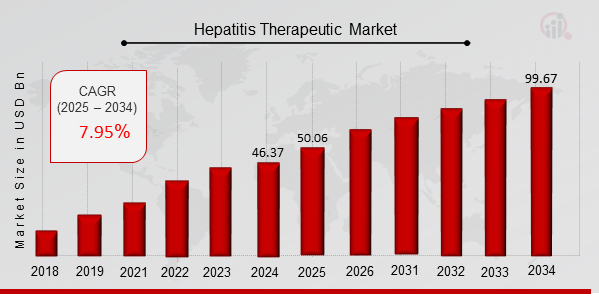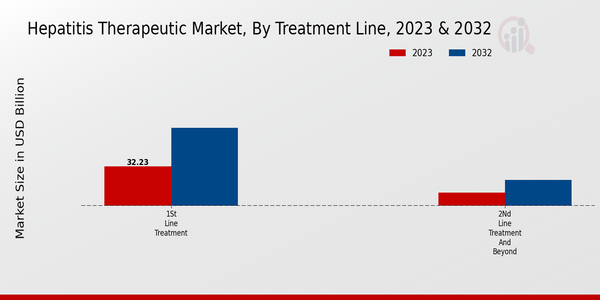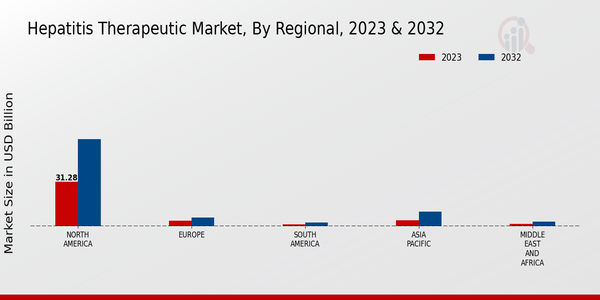Hepatitis Therapeutic Market Overview
As per MRFR analysis, the Hepatitis Therapeutic Market Size was estimated at 46.37 (USD Billion) in 2024. The Hepatitis Therapeutic Market Industry is expected to grow from 50.06 (USD Billion) in 2025 to 99.67 (USD Billion) till 2034, at a CAGR (growth rate) is expected to be around 7.95% during the forecast period (2025 - 2034).
Key Hepatitis Therapeutic Market Trends Highlighted
Recent trends in the Hepatitis Therapeutic Market reveal a growing focus on precision medicine and combination therapies. The advent of direct-acting antivirals (DAAs) has revolutionized the treatment of Hepatitis C, with cure rates surpassing 90%.
Ongoing research aims to develop pan-genotypic therapies effective against all Hepatitis C genotypes. Furthermore, there is a significant unmet need for effective treatments for Hepatitis B, driving innovation in immunotherapies and epigenetic modulators.
The market is also witnessing the rise of personalized medicine approaches, tailoring treatments to individual patient profiles and disease characteristics.
 Source: Primary Research, Secondary Research, MRFR Database and Analyst Review
Source: Primary Research, Secondary Research, MRFR Database and Analyst Review
Hepatitis Therapeutic Market Drivers
Rising Prevalence of Hepatitis
The increasing incidence of hepatitis infections is a major driver of the Global Hepatitis Therapeutic Market Industry. Chronic hepatitis B and C affect millions of people worldwide, and the number of cases is rising.
This is due to several factors, including the increasing use of intravenous drugs, unsafe blood transfusions, and sexual contact with infected individuals. The rising prevalence of hepatitis is fueling the demand for effective treatments, which is driving the growth of the market.
The World Health Organization (WHO) estimates that there are approximately 354 million people living with chronic hepatitis B and 58 million people living with chronic hepatitis C.
The majority of these individuals are unaware of their infection, and many do not receive treatment. This is because hepatitis can be asymptomatic for many years, and by the time symptoms develop, the disease may be advanced.
The rising prevalence of hepatitis is a major public health concern. It can lead to serious liver damage, cirrhosis, and liver cancer. In addition, hepatitis can have a significant impact on the quality of life. Individuals with hepatitis may experience fatigue, nausea, vomiting, and abdominal pain.
They may also be at an increased risk of developing other health problems, such as diabetes and cardiovascular disease. The increasing prevalence of hepatitis is driving the demand for effective treatments. There are a number of different treatments available for hepatitis, including antiviral medications, injections, and liver transplants.
The type of treatment that is recommended will depend on the type of hepatitis virus, the stage of the disease, and the individual's overall health. The Global Hepatitis Therapeutic Market Industry is expected to grow significantly in the coming years.
This growth will be driven by the rising prevalence of hepatitis, the increasing demand for effective treatments, and the development of new and innovative therapies.
Increasing Government Support
Governments around the world are increasingly recognizing the importance of addressing the hepatitis epidemic. This is leading to increased funding for hepatitis prevention and treatment programs. In addition, governments are working to improve access to care for hepatitis patients.
For example, the World Health Organization (WHO) has launched a global strategy to eliminate viral hepatitis by 2030. This strategy includes a number of targets, such as reducing the number of new hepatitis infections by 90% and reducing the number of deaths from hepatitis by 65%.
The Global Hepatitis Therapeutic Market Industry is expected to benefit from the increasing government support for hepatitis prevention and treatment programs.
This support will help to raise awareness of hepatitis, increase access to care, and improve the quality of care for hepatitis patients.
Technological Advancements
The Global Hepatitis Therapeutic Market Industry is also being driven by technological advancements. New and innovative therapies are being developed that are more effective and have fewer side effects. These therapies are helping to improve the quality of life for hepatitis patients and are also reducing the cost of care.
For example, direct-acting antivirals (DAAs) are a new class of drugs that are used to treat hepatitis C. DAAs are highly effective and have a low risk of side effects.
They have revolutionized the treatment of hepatitis C and have helped to cure millions of people. The development of new and innovative therapies is expected to continue to drive the growth of the Global Hepatitis Therapeutic Market Industry. These therapies are helping to improve the quality of life for hepatitis patients and are also reducing the cost of care.
Hepatitis Therapeutic Market Segment Insights
Hepatitis Therapeutic Market Treatment Line Insights
The Global Hepatitis Therapeutic Market is segmented into treatment lines, which includes 1st line treatment, 2nd line treatment and beyond. The 1st line treatment segment accounted for the largest share of the market in 2023 and is expected to continue to dominate the market over the forecast period.
The growth of this segment can be attributed to the increasing prevalence of hepatitis B and C, as well as the availability of effective first-line treatment options. The market growth is attributed to the rising prevalence of hepatitis B and C, increasing awareness of the disease, and the availability of new and innovative treatment options.
The market is also expected to benefit from the increasing government support for hepatitis B and C prevention and treatment programs.
The high prevalence of hepatitis B and C in these regions is a major factor driving the growth of the market.
 Source: Primary Research, Secondary Research, MRFR Database and Analyst Review
Source: Primary Research, Secondary Research, MRFR Database and Analyst Review
Hepatitis Therapeutic Market Spectrum of Disease Insights
The Global Hepatitis Therapeutic Market is segmented based on the Spectrum of Disease into Chronic Hepatitis, Decompensated Cirrhosis, and
Hepatocellular Carcinoma treatment. Chronic Hepatitis held the largest market share in 2023, owing to the high prevalence of chronic hepatitis B and C infections worldwide.
The increasing incidence of cirrhosis and hepatocellular carcinoma is expected to drive the growth of the Decompensated Cirrhosis and Hepatocellular Carcinoma segments, respectively. The Global Hepatitis Therapeutic Market revenue for Chronic Hepatitis is projected to reach USD 24.71 billion by 2032, growing at a CAGR of 7.8%.
The Decompensated Cirrhosis segment is expected to grow at a CAGR of 8.1%, reaching a market size of USD 10.03 billion by 2032. The Hepatocellular Carcinoma segment is expected to witness the fastest growth, with a CAGR of 8.3%, and is projected to reach a market size of USD 7.46 billion by 2032.
Hepatitis Therapeutic Market Subtypes of Hepatitis Insights
The Global Hepatitis Therapeutic Market is segmented into subtypes of Hepatitis, which include Hepatitis B (HBV) and Hepatitis C (HCV). The HBV segment accounted for a larger share of the market in 2023 and is expected to continue to dominate the market during the forecast period.
The increasing prevalence of chronic HBV infection, coupled with the availability of effective antiviral therapies, is driving the growth of the HBV segment. The HCV segment is also expected to witness significant growth during the forecast period, owing to the increasing adoption of direct-acting antiviral (DAA) therapies.
The DAA therapies offer high cure rates and have a shorter duration of treatment, which is contributing to the growth of the HCV segment.
The Global Hepatitis Therapeutic Market is expected to witness robust growth over the forecast period, driven by the increasing prevalence of Hepatitis, the growing adoption of new and effective therapies, and the increasing healthcare expenditure in developing countries.
Hepatitis Therapeutic Market Drug Class Insights
The global Hepatitis Therapeutic Market is segmented by drug class into antivirals and immunomodulators. Antivirals are the most commonly used class of drugs for the treatment of hepatitis, and they work by inhibiting the replication of the hepatitis virus.
Immunomodulators, on the other hand, work by modulating the immune system to help fight the infection. Antivirals accounted for the largest share of the global Hepatitis Therapeutic Market in 2023, and this trend is expected to continue in the coming years.
The growth of the antivirals segment is being driven by the increasing prevalence of hepatitis C virus (HCV) infection, as well as the development of new and more effective antiviral drugs.
Immunomodulators are expected to be the fastest-growing segment of the global Hepatitis Therapeutic Market over the forecast period. This growth is being driven by the increasing use of immunomodulators in the treatment of hepatitis B virus (HBV) infection, as well as the development of new and more effective immunomodulators.
The Global Hepatitis Therapeutic Market is expected to grow from USD 39.79 billion in 2023 to USD 79.2 billion by 2032, at a CAGR of 7.95%.
Hepatitis Therapeutic Market Route of Administration Insights
The Global Hepatitis Therapeutic Market is segmented by Route of Administration into Oral and Injectable. The Oral segment held the largest market share in 2023 due to the ease of administration and patient preference for oral medications.
The Injectable segment is expected to grow at a faster CAGR over the forecast period due to the increasing adoption of injectable therapies for the treatment of chronic hepatitis. In 2023, the Oral segment accounted for approximately 60% of the Global Hepatitis Therapeutic Market revenue, while the Injectable segment is expected to account for approximately 40%.
By 2032, the Oral segment is expected to account for approximately 55% of the market revenue, while the Injectable segment is expected to account for approximately 45%.
The growth of the Injectable segment is expected to be driven by the increasing adoption of long-acting injectable therapies, which offer sustained drug release and improved patient compliance. The development of new and more effective injectable therapies is also expected to contribute to the growth of this segment.
Hepatitis Therapeutic Market Regional Insights
The regional segmentation of the Global Hepatitis Therapeutic Market presents distinct opportunities and challenges for market participants. North America holds a significant share of the market, driven by factors such as high healthcare expenditure, advanced healthcare infrastructure, and a large patient population with chronic hepatitis.
The market in Europe is also well-established, with a focus on innovative therapies and precision medicine. The Asia-Pacific region is expected to witness substantial growth in the coming years, fueled by rising healthcare awareness, increasing prevalence of hepatitis, and government initiatives to improve healthcare access.
South America and the Middle East and Africa (MEA) regions represent emerging markets with untapped potential, offering significant growth opportunities for market players. The market in these regions is expected to be driven by rising disposable income, expanding healthcare infrastructure, and increasing awareness about hepatitis.
 Source: Primary Research, Secondary Research, MRFR Database and Analyst Review
Hepatitis Therapeutic Market Key Players and Competitive Insights:
Source: Primary Research, Secondary Research, MRFR Database and Analyst Review
Hepatitis Therapeutic Market Key Players and Competitive Insights:
Major players in the Hepatitis Therapeutic Market industry are constantly striving to gain a competitive edge by investing in research and development, expanding their product portfolios, and forming strategic partnerships.
Leading Hepatitis Therapeutic Market players are focusing on developing innovative therapies that target specific genotypes of the hepatitis virus and offer improved efficacy and safety profiles. The Hepatitis Therapeutic Market development landscape is characterized by a high level of collaboration between pharmaceutical companies, research institutions, and government agencies.
Companies are actively involved in clinical trials to evaluate the safety and efficacy of new Hepatitis Therapeutic Market products. The competitive landscape is expected to remain dynamic, with new entrants and mergers and acquisitions shaping the market dynamics.
One of the leading Hepatitis Therapeutic Market players, Gilead Sciences, has established a strong position in the market with its blockbuster drug, Sovaldi. Sovaldi is a directly acting antiviral that has revolutionized the treatment of hepatitis C.
Gilead Sciences is continuing to invest in research and development to maintain its leadership position. Another major player in the Hepatitis Therapeutic Market is Merck Co., which has a diverse portfolio of hepatitis drugs, including Zepatier and Harvoni. Merck Co. is focusing on developing new therapies for hepatitis B and hepatitis D.
AbbVie is a rapidly growing Hepatitis Therapeutic Market player with a robust pipeline of new products. The company's lead product, Mavyret, is a combination therapy for hepatitis C that has demonstrated high efficacy rates.
AbbVie is also developing treatments for hepatitis B and other liver diseases. These leading players are constantly striving to gain a competitive edge by investing in research and development, expanding their product portfolios, and forming strategic partnerships.
Key Companies in the Hepatitis Therapeutic Market Include
- GlaxoSmithKline
- AstraZeneca
- Sanofi
- Roche
- Johnson Johnson
- Merck Co.
- Vir Biotechnology
- Novartis
- Arbutus Biopharma
- Allergan
- Shionogi Co.
- Pfizer
- Gilead Sciences
- AbbVie
- Bristol Myers Squibb
Hepatitis Therapeutic Market Industry Developments
Recent news and current affairs in the global hepatitis therapeutics market highlight promising developments and advancements. In 2023, the market witnessed several key milestones, including regulatory approvals for new therapies, clinical trial successes, and strategic partnerships among pharmaceutical companies.
Notably, the US Food and Drug Administration (FDA) approved the first oral therapy for chronic hepatitis B, offering a significant breakthrough in the treatment landscape. Additionally, clinical trials for novel therapies targeting different hepatitis viruses have shown promising results, raising expectations for expanded treatment options in the future.
Furthermore, collaborations between pharmaceutical companies have accelerated research and development efforts, fostered innovation and driven the market forward. These developments underscore the dynamic and rapidly evolving nature of the global hepatitis therapeutics market.
Hepatitis Therapeutic Market Segmentation Insights
Hepatitis Therapeutic Market Treatment Line Outlook
- 1st Line Treatment
- 2nd Line Treatment and Beyond
Hepatitis Therapeutic Market Spectrum of Disease Outlook
- Chronic Hepatitis
- Decompensated Cirrhosis
- Hepatocellular Carcinoma
Hepatitis Therapeutic Market Subtypes of Hepatitis Outlook
- Hepatitis B (HBV)
- Hepatitis C (HCV)
Hepatitis Therapeutic Market Drug Class Outlook
- Antivirals
- Immunomodulators
Hepatitis Therapeutic Market Route of Administration Outlook
Hepatitis Therapeutic Market Regional Outlook
- North America
- Europe
- South America
- Asia Pacific
- Middle East and Africa
| Report Attribute/Metric |
Details |
|
Market Size 2024
|
46.37 (USD Billion)
|
|
Market Size 2025
|
50.06 (USD Billion)
|
|
Market Size 2034
|
99.67 (USD Billion)
|
|
Compound Annual Growth Rate (CAGR)
|
7.95 % (2025 - 2034)
|
|
Report Coverage
|
Revenue Forecast, Competitive Landscape, Growth Factors, and Trends
|
|
Base Year
|
2024
|
|
Market Forecast Period
|
2025 - 2034
|
|
Historical Data
|
2020 - 2024
|
| Market Forecast Units |
USD Billion |
| Key Companies Profiled |
GlaxoSmithKline, AstraZeneca, Sanofi, Roche, Johnson Johnson, Merck Co., Vir Biotechnology, Novartis, Arbutus Biopharma, Allergan, Shionogi Co., Pfizer, Gilead Sciences, AbbVie, Bristol Myers Squibb |
| Segments Covered |
Treatment Line, Spectrum of Disease, Subtypes of Hepatitis, Drug Class, Route of Administration, Regional |
| Key Market Opportunities |
Growing prevalence of hepatitis Advancements in drug discovery Emerging markets Orphan drug designation Government initiatives |
| Key Market Dynamics |
Increasing prevalence of hepatitis Advancements in treatment options Growing government initiatives Favorable reimbursement policies Rising awareness of hepatitis |
| Countries Covered |
North America, Europe, APAC, South America, MEA |
Frequently Asked Questions (FAQ) :
The Global Hepatitis Therapeutic Market is anticipated to grow at a CAGR of 7.95% from 2025 to 2034.
The Global Hepatitis Therapeutic Market is estimated to reach a valuation of USD 99.67 billion by 2034.
North America is expected to dominate the Global Hepatitis Therapeutic Market throughout the forecast period.
The rising prevalence of hepatitis, increasing awareness, and technological advancements are major factors propelling the market growth.
The chronic hepatitis segment is projected to register the highest CAGR during the forecast period.
Key players in the market include Gilead Sciences, Merck Co., Inc., Bristol-Myers Squibb, and AbbVie Inc.
The Global Hepatitis Therapeutic Market was valued at approximately USD 39.79 billion in 2023.
Asia-Pacific is anticipated to witness the highest CAGR during the forecast period.
Patent expiries, stringent regulatory policies, and the emergence of biosimilars pose challenges to market growth.
The rising prevalence of hepatitis fuels the demand for therapeutic interventions, contributing to market growth.

















